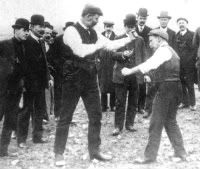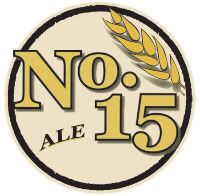Did it get quiet in here or is it just me? Oh, right, it was just me.
So, you were probably anticipating some exciting birthday videos full of excitement, drama, and romance weren’t you? I’m sorry to report the lighting in the Schlafly Taproom was not bright enough to allow for filming with our equipment. Alas, t’was not meant to be.
What did you miss out on? Well, we arrived just in time to see
Tom Schlafly and
Jim Koch getting in an all-out fistfight with
August A Busch returned from the dead. They almost had him on the run when suddenly
Frederick Miller arrived in a portal of hellfire and joined the brawl. When the dust settled, the four realized they had nothing to fight about since they all made decent beer and decided to vent their anger on the
prohibition movement. 
When they managed to get all the tables and the dining room back into place my friends and family and I were seated. The ladies present each had one of the samplers just to try a little bit of everything, but after reading a review of hefty praise from a fellow Missouri beer nut I tried out the No. 15.
Appearance: Kind

of a thin head, maybe about a finger or two, which faded to a thin coating for the rest of the drink. It laced well, though, and had a rich color around a deep reddish tint.
Smell: A wheat background and fruity.
Taste: Very very sweet. The canvas was wheat, but there was a fruitiness I had a hard time placing. After having a roundtable consensus with my friends and family we agreed it was something like pears or cinamon apples, but I’ve heard a lot of people say it tasted like apricot which I would wholly believe. Very tasty, and it didn't take much for me to polish the whole thing off. If you're more of a fan of bitters, you might not find much satisfaction here, as the hops were very downplayed in favor of the fruits working around.
Mouthfeel: It was smooth, felt kind of medium, but was neither very carbonated, nor was it terribly creamy. Honestly, the flavor of the drink was king over all the other traits one typically looks at in a beer.
Drinkability: I'd rate this as high. I, and everyone trying the beer with me, held it in high regard. This is something I could see easily becoming a staple in my fridge for when I'm just relaxing, though with the strong sweetness to it, it would be easy to become over-exposed if this were the only thing you were drinking. Definitely one I'm keeping in mind for my session of choice, though!
The tally for birthday presents was incredibly beer-related. I wonder what kind of message I’ve been spreading amongst my friends! Not that I’m complaining at all… I have no shortage of drinks to try right now. I got a Schlafly shaker pint glass, as well as a tee from the taproom proudly proclaiming that beer is “Not just for breakfast anymore!” My wife gave me two novels I was wanting to read very much (neither of them beer related thankfully) as well as a new battery for the laptop I write on (again, no beer relation unless you count this article). I picked up Randy Mosher’s Tasting Beer and Michael Jackson’s (No, not that one, this one) Great Beer Guide. Two of my loyal readers (A couple who both use the screen name Sqrt(D)) provided me with several weeks worth of beer to work on reviews, so just you wait! I also received a giant 24 case of Leinenkeugals assorted. Right now I’ve settled down to read this with my new pint glass full of their Red Ale, which I have to say I’m really liking.
Since this weekend is always a shared birthday weekend between me and Kaiser Crowbar (a close and personal friend, as well as world conquering maniac) we spent the days out and about. In the last week I’ve discovered a second beer that I really like: Samuel Adam’s Boston Lager. Now, I had decided when laying out this blog that I wouldn’t do a review on it on the simple basis that the idea is to try new stuff. But wait! You said you just found out you loved it! Yeah… Just found out about that last part. I’d had it a few years back before I’d really developed a tasted and it left me wanting. Of course, I had no idea what I was drinking back then.
Between that and the Number 15, I’ve found two very solid session beers. Although obviously the Sam Adams is going to be a lot easier to find when bar jumping.
Anyway, have a great weekend and I’ll see you again Sunday!









